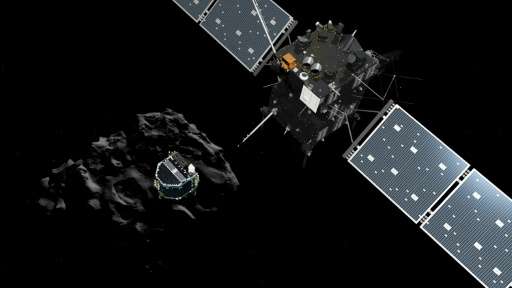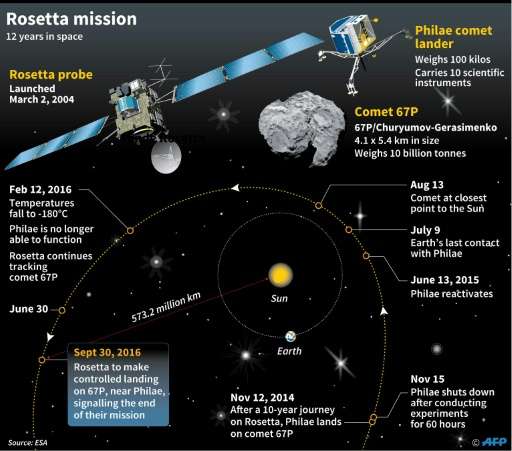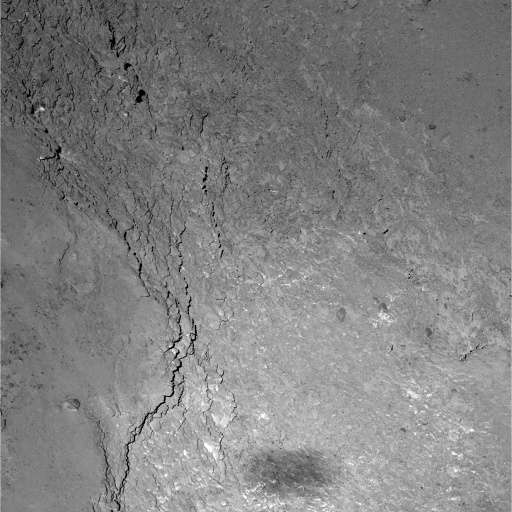Rosetta: What did Europe's comet mission uncover?

Europe's Rosetta spacecraft, due to switch off Friday (Sept 30) after a 12-year odyssey, carried 11 scientific instruments to sniff, smell and photograph a comet from all angles.
After arriving in orbit around comet 67P/Churyumov-Gerasimenko, it launched Philae, a separate lander, which had another ten hi-tech gadgets, including a drill that never deployed, but also cameras, X-ray scans and radio wave probes.
Together, the robot explorers have advanced our understanding of comets, of which there are billions, believed to be leftovers from the birth of our Solar System some 4.6 billion years ago.
"Nobody had any idea comets can be so weird until Rosetta got there," said Fabio Favata of the European Space Agency's (ESA) robotic exploration directorate.
67P/Churyumov-Gerasimenko is currently 710 million kilometres (440 million miles) from Earth.
Read also: Rosetta: The end of a space odyssey
What the mission found:
Shapely
Expecting to encounter something roughly the shape of an American football, scientists were flabbergasted to observe through Rosetta's cameras that 67P resembled a rubber bath duck with a distinct "body" and "head", and a crack through its "neck".
Some scientists have since postulated that this shape was not created by erosion, but a low-velocity impact billions of years ago between two objects which fused.
This all suggests the comet was formed in a young, outer part of our Solar System that was much less densely packed with bodies than previously thought.
If not, 67P "is so fragile it should have been clobbered by something else and broken apart," ESA senior science advisor Mark McCaughrean told AFP.
This affects our understanding of planetary formation, thought to have happened when ice and dust debris, swirling around in a proto-planetary disk around an infant Sun, collided and stuck together, growing bigger and bigger over time.

But hard
The comet's surface was another surprise.
It was less "fluffy" and much harder than expected, which contributed to Philae bouncing several times after its harpoons failed to fire on landing.
The comet had much less water ice than thought, was littered with pebbles and rocks ranging in size from a few centimetres (inches) across to five metres (18 feet), and pocked with deep craters. The surface is rendered super-dark and non-reflective by a thin layer of dust.
Surprise!
Scientists were astonished to find oxygen molecules in the gassy halo around the comet, and said they appeared to be older than our Solar System.
Scientific models had previously calculated that oxygen as a molecular compound on its own would not have existed at the time the comet was formed, as it would have bound with other elements like hydrogen.
So, how the comet got its oxygen remains a mystery.
Life's beginnings
67P has organic molecules, many different ones—including amino acids which are the building blocks of life as we know it.
This discovery supports the hypothesis that comets may very well have helped spark life on Earth by delivering organic materials when they slammed into a young planet that was basically molten iron.
No H2O

Water, on the other hand, is unlikely to have come from comets of 67P's type, the mission found.
The water on Rosetta is of a very different "flavour" than that on our planet, with three times more deuterium, a heavy hydrogen isotope.
Stinker
Analysing the comet's chemical signature, Rosetta scientists concluded it probably smells like a noxious mix of rotten eggs, horse urine, alcohol and bitter almonds.
"If you could smell the comet, you would probably wish that you hadn't," the ESA team said at the time.
No attraction
Philae's magnetometer found that, surprisingly, 67P has no measurable magnetic field—throwing into question another key theory on the formation of solar system bodies.
It implied that magnetism played no part in debris in the early Solar System clumping together to form planets, comets, asteroids and moons.
Not over yet
Scientists expect that the data extracted by Philae and Rosetta will keep them busy for decades to come.
"The metaphor I used at the beginning, was Rosetta would be the key that would unlock the treasure chest to the secrets of the Solar System. I think... we found the key, it's on the floor and it's in pieces. We need to assemble the key first before we can unlock the treasure chest," said McCaughrean.
© 2016 AFP




















